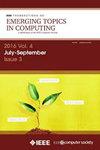On the Privacy of the Count-Min Sketch: Extracting the Top-K Elements
IF 5.1
2区 计算机科学
Q1 COMPUTER SCIENCE, INFORMATION SYSTEMS
IEEE Transactions on Emerging Topics in Computing
Pub Date : 2024-04-04
DOI:10.1109/TETC.2024.3383321
引用次数: 0
Abstract
Estimating the frequency of elements in a data stream and identifying the elements that appear many times (also known as heavy hitters) are needed in many applications such as traffic monitoring in networks or popularity estimate in web and social networks. The Count-Min Sketch (CMS) is probably one of the most widely used algorithms for frequency estimate. The CMS uses a sub-linear space to provide queries for data streams and retrieve an approximate value for the frequency of events. It has been used in many different applications and scenarios, making its security and privacy a matter of interest. This paper considers the privacy of the CMS and presents an algorithm to extract the most frequent elements (also known as top-K) and their estimate from a CMS. This is possible for universes of a limited size; when the attacker has access to the sketch, its hash functions and the counters at a specific point of time. The algorithm is tested using CAIDA traces showing that it is able to retrieve the group of top-K elements with an acceptable percentage of false positives and negatives. The results improve with the size of the sketch and for smaller values of K, indicating that in some practical settings an attacker can extract substantial information about the top-K elements from the sketch. The code used in the simulation is provided in a public open-source repository to facilitate reproducing our results and extending the ideas presented in this paper.论计数-最小草图的隐私性:提取前 K 元素
估计数据流中元素的频率并识别出现多次的元素(也称为heavy hitters)在许多应用中都是需要的,例如网络中的流量监控或web和社交网络中的流行度估计。最小计数草图(CMS)可能是频率估计中使用最广泛的算法之一。CMS使用亚线性空间为数据流提供查询,并检索事件频率的近似值。它已经在许多不同的应用程序和场景中使用,使其安全性和隐私性成为人们感兴趣的问题。本文考虑到CMS的隐私性,提出了一种从CMS中提取最频繁元素(也称为top-K)及其估计的算法。这对于有限大小的宇宙来说是可能的;当攻击者在特定时间点访问草图、其哈希函数和计数器时。该算法使用CAIDA痕迹进行了测试,表明它能够检索具有可接受的假阳性和阴性百分比的top-K元素组。结果随着草图的大小和较小的K值而改善,这表明在一些实际设置中,攻击者可以从草图中提取有关top-K元素的大量信息。模拟中使用的代码在一个公共开源存储库中提供,以方便再现我们的结果并扩展本文中提出的思想。
本文章由计算机程序翻译,如有差异,请以英文原文为准。
求助全文
约1分钟内获得全文
求助全文
来源期刊

IEEE Transactions on Emerging Topics in Computing
Computer Science-Computer Science (miscellaneous)
CiteScore
12.10
自引率
5.10%
发文量
113
期刊介绍:
IEEE Transactions on Emerging Topics in Computing publishes papers on emerging aspects of computer science, computing technology, and computing applications not currently covered by other IEEE Computer Society Transactions. Some examples of emerging topics in computing include: IT for Green, Synthetic and organic computing structures and systems, Advanced analytics, Social/occupational computing, Location-based/client computer systems, Morphic computer design, Electronic game systems, & Health-care IT.
 求助内容:
求助内容: 应助结果提醒方式:
应助结果提醒方式:


